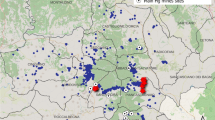Summary
To obtain reference values for blood and serum manganese levels, blood specimens were collected from 29 men and 36 women. Mn in blood showed a normal distribution; its upper 97.5% limit in blood was 0.38 μmol/l. Mn in serum showed a skewed distribution, which did not differ from the normal one after logarithmic transformation. The respective reference limit was 19 nmol/l. In both specimens, the levels of Mn were significantly lower in men than in women. To obtain reference values for Mn in urine, midday urine specimens were collected from 58 men and 96 women. Mn in urine also showed a skewed distribution, and the upper 97.5% limit was 38 nmol/l. The levels of Mn in blood and urine were statistically significantly higher in manual metal arc (MMA) welders of mild steel (MS) than in the reference populations. Five MMA/MS welders were subjected to a further study in which the ambient intramask Mn levels and urinary Mn excretion were monitored throughout a full working week. For two welders the correlation of Mn in urine specimens voided in the afternoon was good with the before noon Mn concentrations in the hygienic measurements; for the rest the correlation was minimal. Mn in diurnal urine specimens collected in six portions showed fluctuation if specific gravity or creatinine in urine was used to standardize for the urinary flow, but it was less evident for urinary Mn excretion rate. Our results seem to indicate that the measurement of Mn in urine or blood may be used for monitoring Mn exposure in MMA/MS welders only at the group level.
Similar content being viewed by others
References
Araki S, Aono H, Yokoyama K, Murata K (1986) Filtrable plasma concentration, glomerular filtration, tubular balance, and renal clearance of heavy metals and organic substances in metal workers. Arch Environ Health 41:216–221
Araki S, Sata F, Murata K (1990) Adjustment for urinary flow rate: an improved approach to biological monitoring. Int Arch Occup Environ Health 62:471–477
Chandra SV, Seth PK, Mankeshwar JK (1974) Manganese poisoning: clinical and biochemical observations. Environ Res 7:374–380
Chandra SV, Shukla GS, Srivastava RS, Singh H, Gupta VP (1981) An exploratory study of manganese exposure to welders. Clin Toxicol 18:407–416
International programme on chemical safety (1981). Environmental health criteria 17. Manganese. World Health Organization, Geneva
Kondakis XG, Makris N, Leotsinidis M, Prinou M, Papapetropoulos T (1989) Possible health effects of high manganese concentration in drinking water. Arch Environ Health 44:175–178
Kumpulainen J, Tahvonen R (1989) Report of the activities of the sub-network on trace elements in food. In: Report on the consultation of the FAO European cooperative network on trace elements. FAO, Rome
Minoia C, Sabbioni E, Apostoli P, et al. (1990) Trace element reference values in tissues from inhabitants of the European community. I. A study of 46 elements in urine, blood and serum of Italian subjects. Sci Total Environ 95:89–105
Morin LG, Prox J (1973) New and rapid procedure for serum phosphorus usingo-phenylenediamine as reductant. Clin Chim Acta 46:113–117
NAS (1973) Manganese. National Academy of Sciences, Washington, DC
Roels H, Lauwerys R, Genet P, Sarhan MJ, Fays M de, Hanotiau I, Buchet J-P (1987) Relationships between external and internal parameters of exposure to manganese in workers from a manganese oxide and salt producing plant. Am J Industr Med 11:297–305
Saric M (1986) Chapter 15. Manganese. In: Friberg L, Nordberg GF, Vouk V (eds) Handbook on the toxicology of metals, 2nd edn. Elsevier, Amsterdam, pp 354–386
Simon M, Cuan J (1980) C-terminal parathyrin (parathyroid hormone) radioimmunoassay in serum with commercially available reagents. Clin Chem 26:1666–1671
Sjögren B, Hedström L, Lindstedt G (1984) Urinary fluoride concentration as an estimator of welding fume exposure from basic electrodes. Br J Ind Med 41:192–196
Tola S, Kilpiö J, Virtamo M, Haapa K (1977) Urinary chromium as an indicator of the exposure of welders to chromium. Scand J Work Environ Health 3:192–202
Versieck J, Cornelis R (1980) Normal levels of trace elements in human blood plasma or serum. Anal Chim Acta 116-217–254
Versieck J, Barbier F, Cornelis R, Hoste J (1982) Sample contamination as a source of error in trace-element analysis of biological samples. Talanta 29:973–984
WHO (1980) Recommended health-based limits in occupational exposure to heavy metals. Techn Rep Ser no. 647. World Health Organization, Geneva
Young DS (1979) Chapter 1. Biological variability. In: Brown SS, Mitchell FL, Young DS (eds) Chemical diagnosis of disease. Elsevier, Amsterdam, pp 1–113
Zschiesche W, Wilhelm E, Zober A, Schaller KH, Weltle D, Valentin H (1986) Manganese in stainless steel welding fumes: external exposure and biological monitoring. In: Stern RM, Berlin A, Fletcher AC, Järvisalo J (eds) Health hazards and biological effects of welding fumes and gases. Elsevier, Amsterdam, pp 193–196
Author information
Authors and Affiliations
Additional information
These results were presented in part at the 2nd COMTOX meeting, held in Montreal in 1983
Rights and permissions
About this article
Cite this article
Järvisalo, J., Olkinuoral, M., Kiilunen, M. et al. Urinary and blood manganese in occupationally nonexposed populations and in manual metal are welders of mild steel. Int. Arch Occup Environ Heath 63, 495–501 (1992). https://doi.org/10.1007/BF00572116
Received:
Issue Date:
DOI: https://doi.org/10.1007/BF00572116




